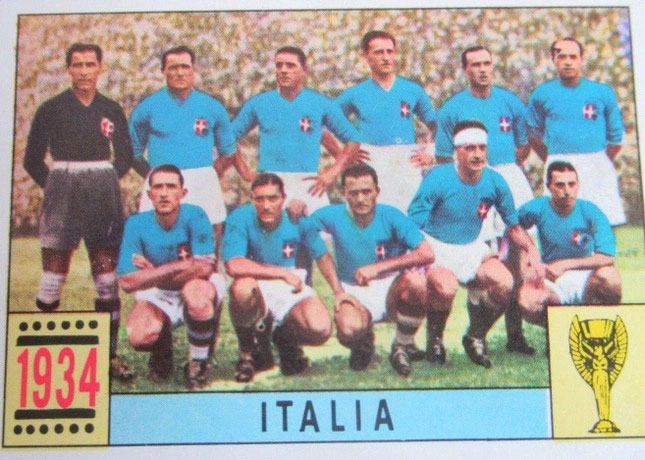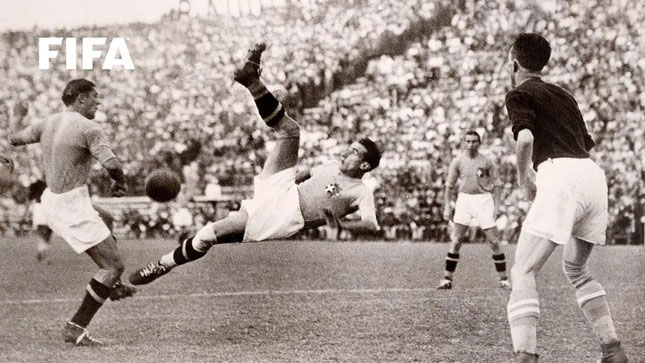The success of the 1930 World Cup created a significant impact, making the tournament an effective promotional event for the host nation. This is why the dictator Benito Mussolini was determined to bring the 1934 World Cup to Italy and subsequently “manipulated” it strongly to help the Azzurri win the championship.
“Manipulation” is a term that haunted many who participated in the 1934 World Cup when discussing the tournament. According to various articles and documents published after World War II, dictator Benito Mussolini intervened heavily to help the Italian national team win the championship.

The Italian national team in 1934.
Benito Mussolini quickly recognized that football was an extremely effective populist tool. From the moment he took office as Prime Minister of Italy, Mussolini showed great interest in both the national league and the national team. When he saw the opportunity to showcase the power and influence of the World Cup, this dictator was determined to bring the second FIFA World Cup to the land of pasta.
Italy defeated Sweden in the race to host the 1934 World Cup by establishing perfect infrastructure for the tournament early on, with grand stadiums built to FIFA standards. At the same time, Italy announced a “huge” budget for the World Cup 1934, amounting to 3.5 million lira (equivalent to about 30 million USD today). At a time when sports had not yet become a money-making machine as they are now, this amount from the Italians was truly staggering.
In the 1934 World Cup, FIFA applied a qualifying round for the first time. 32 teams would compete to select 16 teams for the Finals. However, the reigning champion Uruguay declined to participate, protesting against several European nations that refused to travel to South America for the previous World Cup hosted by this South American country in 1930. Thus, the 1934 World Cup was the only tournament where the reigning champions did not participate.
Meanwhile, despite being the host nation, Italy still had to go through the qualifying round, which is the only time a World Cup host team needed to do so. Of course, having to qualify did not pose any difficulties for Italy.

Italy achieved relatively easy victories.
They defeated Greece 4-0 to secure a spot in the World Cup Finals thanks to goals from Guarisi, Meazza (2 goals), and Ferrari. The Italian national team that year was a formidable force in Europe, boasting a dream team of star players, including two of the world’s top superstars at the time, Giuseppe Meazza and Luis Monti.
However, the real star of the Italians, according to many football historians in Europe, did not need to lace up his boots. That person was Benito Mussolini. Although the Azzurri were very strong, to ensure that the championship would remain in the boot-shaped country, this dictator is believed to have intervened brutally in the management of the organizing committee to facilitate Italy’s path to glory.
Italy had a fantastic start with a 7-1 victory over the United States, but they were not the only standout team to succeed in the first round. Sweden defeated the 1930 runner-up Argentina before 14,000 spectators in Bologna, sending Argentina home after just one match on Italian soil. Germany, thanks to a hat-trick from Edmund Conen, who made his debut with the national team, also beat Belgium 5-2 in Florence.
In the quarter-finals, Italy faced Spain and experienced a legendary clash known for its brutality. A significant number of violent acts were committed by both sides. Some players had to be carried off the field, and Italian midfielder Mario Pizziolo, who suffered a broken leg in this match, was never able to play for the Azzurri again. Meanwhile, legendary Spanish goalkeeper Ricardo Zamora was also injured during Italy’s equalizing goal.
The match ended in a 1-1 draw, which meant an immediate replay according to tournament regulations. La Roja would have to play without their talisman, captain, and outstanding goalkeeper Ricardo Zamora, but the Azzurri also faced difficulties with the loss of Pizziolo. The match was scheduled for the next day, June 1, at the Giovanni Berta Stadium in Florence, and Italy won 1-0 thanks to a goal from Giuseppe Meazza.
The way the Azzurri struggled to reach the semi-finals made Mussolini uneasy. According to Italian football historian Marco Impiglia, this dictator intervened to ensure that the story of the quarter-finals would not repeat itself for the Italian team. Mussolini invited referee Ivan Eklind, who would officiate the semi-final match between Italy and Austria, to dinner. What Mussolini said during that dinner remains a mystery to this day. However, one thing is clear: Eklind officiated the semi-final match in favor of Italy.
The clearest evidence was Italy’s only goal in this semi-final match in the 19th minute. Despite protests from the Austrian players, Eklind recognized the goal by Enrico Guiata of Italy, even though the striker was offside and the Austrian goalkeeper had been violently pushed in the previous play. Moreover, in the final, when Italy defeated Czechoslovakia 2-1, the referee was still… Eklind.
The world championship that year was controversially awarded to Italy. This somewhat tarnished the efforts of a talented collective under the guidance of the excellent coach Vittorio Pozzo. However, for Benito Mussolini, the Azzurri’s first ascent to the pinnacle of the world was still an important success in promoting fascism and the influence of this dictator.
In fact, recognizing the effectiveness of using football as a political stepping stone, by the 1938 World Cup, Mussolini was believed to have intervened again to help the Azzurri successfully defend their championship in this tournament.
WORLD CUP 1934
|

















































